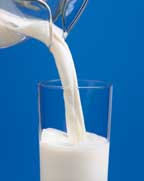Calcium Sources
Calcium carbonate and calcium citrate are the main forms of calcium added to foods and beverages. Other forms of calcium added to products include calcium lactate, calcium chloride, calcium fumarate, calcium phosphate, dicalcium phosphate, tricalcium phosphate, calcium glycerophosphate, calcium gluconate, and calcium sulfate, and blends of these calcium forms.Recently, researchers have been investigating a source of calcium called “milk calcium,” a concentrated source of calcium and other minerals derived from milk. Producing milk calcium, available as a fine powder in different granulations, involves extracting minerals directly from the whey stream. Besides calcium, it includes minerals important for bone growth such as phosphorus, magnesium, potassium, sodium, iron, and zinc.
Phosphorus is needed for effective calcium absorption and bone repair. Milk calcium provides the 2:1 calcium to phosphorus ratio that is optimal for enhancing bone density, according to recent research.

“Human bone has a 2:1 ratio of calcium to phosphorus,” says Hollermann. “When people who especially need calcium, such as osteoporosis therapy patients and many of the elderly, are given a calcium supplement that does not contain phosphorus, they can end up with a phosphorus deficiency.”
Research published in the Journal of the American College of Nutrition showed that osteoporosis patients should receive their calcium in the form of calcium phosphate. The researchers showed that as calcium intake increases without an increase in phosphorus, total phosphorus absorption falls and the risk for phosphorus deficiency increases. Phosphorus deficiency may make calcium supplementation less effective and could lead to increased bone loss, according to the study.
Other trials have shown that milk calcium's higher bioavailability has a longer-lasting effect on bone mass. In a follow-up study published in The Lancet, researchers found that an increase in bone mass in prepubertal girls whose diets were supplemented with milk calcium lasted several years after the study—without further supplementation.
All dairy-derived products contain calcium, except for butterfat. Generally, the higher the fat content, the lower the calcium content. Nonfat dry milk is probably the most popular way to fortify a product with calcium because it is the least expensive of the dairy-derived ingredients and there are fewer issues with off-flavors. Different ingredients have various amounts of calcium. As a reference, eight ounces of fluid milk contains about 300mg calcium (or 30% DV). Nonfat dry milk contains about 1300mg calcium per 100g of powder. It takes one-third cup of NFDM powder (280mg calcium) to make one cup of fluid milk. Dry sweet whey contains 770mg Ca/100g and dry acid whey contains 2280mg Ca/100g, according to figures from Dairy Management Inc., Rosemont, Ill. Cheese solids and powders also contain calcium.
Labeling Issues
While the other calcium sources must be listed as “calcium carbonate” or whatever the chemical composition, milk calcium can be listed by many names that are acceptable by the Food and Drug Administration. These include milk mineral complex, whey mineral complex, milk mineral or whey mineral concentrate, dairy calcium, milk calcium, or milk minerals.Nutrient content claims regarding calcium are allowed by the FDA as follows:
- Foods containing 20% or more of the calcium DV can be listed as “High in Calcium,” “Rich in Calcium,” or an “Excellent Source of Calcium.”
-
A food containing 10% to 19% of the calcium DV can say, “Contains Calcium,” “Provides Calcium,” or is a “Good Source of Calcium.”
- Foods containing 10% or more of the calcium DV, when compared to a standard serving size of a similar food, can say they are “Calcium Enriched,” “Calcium-Fortified,” or have “More Calcium.”
Applications
When formulating foods for calcium enrichment, dairy ingredients can provide a sound foundation for building on this with calcium-containing ingredients.Ingredients containing calcium can be incorporated into a variety of foods and beverages.
A functional chai tea, shown at IFT this past June, contains nonfat dry milk, whole milk powder, and milk calcium, as well as a spice blend and honey powder. Lactoferrin was added as an iron-binding whey protein that studies indicate may have multiple biological functions. One serving of the formula provides 30% of the DV of calcium and 3g of protein.
“We usually add milk calcium to various products to increase the calcium content,” says Podgurski. “Milk minerals are very soluble compared to some of the inorganic salts such as calcium carbonate.” Solubility is especially important in formulating beverages. Using a smaller granulation of calcium can help.
In adding calcium-containing ingredients to foods or beverages, formulators should never add 100% DV to a single serving. A glass of milk contains 30%, which is a good upper limit for fortification. Calcium is best absorbed in the body in small amounts, taken several times throughout the day.
Sidebar: Dairy-Based Ingredients
Over a century of R&D on enzymes and cultures enables Chr. Hansen to develop functional, high-quality and cost effective enzyme-modified and fermented dairy flavors. The company's fresh fermented dairy notes, European cheese flavors, cultured/lipolyzed creams, and compounded and reaction butters enhance flavor profiles; mask off-flavors; improve mouthfeel; and are bake, retort and microwave stable. Chr. Hansen Inc., Farshid Eftekhari, 800-558-0802,FEftekhari@chr-hansen-us.com
This company manufactures quality food ingredients, including CenPrem™ brand commodity dairy powders, replacers and blends; a complete line of whey protein concentrates and isolates; Nu-Century whey powder; Isolac® brand whey protein isolate; and a complete line of caseins and caseinates. Century Foods, Rick Halverson, 608-269-1900, info@centuryfoods.com

Ideal for dry-powdered beverages, Proliant introduces 8360 Instantized Whey Protein Hydrolysate. It offers quick, cold-water dispersibility, good solubility, emulsifying and flowing properties, while providing a readily digestible source of protein and peptides that require less energy and absorption time. Proliant, 800-369-2672, dairyingredients@proliantinc.com, www.proliantinc.com
One of the world's leading suppliers of whey protein concentrates and other types of milk proteins, MILEI GmbH also is an ISO 9001 manufacturer. The company's products offer superior nutritional properties as well as versatile functional attributes. The North American agent for Milei is Dairy Specialties Inc. MILEI GmbH, David H. Brown, 614-855-2331, dsibrown@aol.com
Among the dairy ingredients this company supplies are Eggstend and Dairy-Lo. Eggstend is a dairy-based powder used to partially or totally replace whole egg. Dairy-Lo provides a variety of functions, including texture modification, opacity and water-binding. It also replaces fat in a variety of formulations. Parmalat, Rhonda Ryan, 416-620-3081, rhonda_ryan@parmalat.ca
A hydrolyzed whey protein isolate, BioZate1, is offered by Davisco Foods International Inc. The company has conducted a clinical study on BioZate1's antihypertensive effects, finding a significant drop in blood pressure. For a complete abstract of the study, visit www.DaviscoFoods.com. Davisco Foods International Inc., 952-914-0400.
Many options for shelf-stable, convenient dairy ingredients and flavorings are available from Kerry Specialty Ingredients, a division of Kerry North America. Items offered are spray-dried cheese and cultured dairy powders that deliver excellent flavor and functionality to cheese chips that feature the characteristics of cheese but require no refrigeration. Kerry Specialty Ingredients, 800-328-7517.
Sidebar: Whey Proteins
Whey proteins, valuable components of whey, are readily digestible and completely bioavailable.Whey protein concentrates (WPC) have multifunctional properties. They are derived from whey by removing sufficient non-protein constituents, such as lactose and minerals, by various methods. Ultrafiltration is one common method that typically produces ingredients that range in protein content from 34% to 80%. Low molecular weight compounds such as lactose, minerals, non-protein nitrogen and vitamins are filtered from the whey to the permeate, and the proteins are concentrated in the retentate. WPCs also contain lactose, vitamins, minerals, and some fat, which help them function in gel structure, water binding, browning, and aeration.
WPC-34 (34% protein) is one of the most common whey protein concentrates used by food manufacturers. Suppliers can modify WPCs for various applications by altering pH and heat treatments or combining several parameters. Applications include (but are not limited to) meat, sauces, dressings, dips and bakery products. These functional ingredients can be designed for freeze/thaw stability, increasing viscosity, water binding, adding creaminess, forming gels and serving as emulsifiers.
Whey protein isolate (WPI) contains 90% or more protein. Hydrolyzed WPI has been in the forefront recently. Research has shown that, through certain hydrolysis processes, inhibitory substances called angiotensin converting enzyme (ACE) are released. These bioactive peptides inhibit the ACE enzyme from catalyzing the process that causes hypertension, and serves to lower blood pressure.